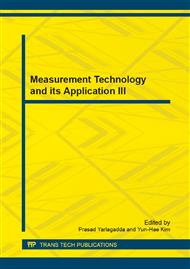[1]
M. Pedersen, J.Y. Hardeberg, Full-Reference Image Quality Metrics, Now Publishers, Incorporated, (2012).
Google Scholar
[2]
C.T. Vu, T.D. Phan, and D.M. Chandler, S3: A spectral and spatial measure of local perceived sharpness in natural images, IEEE Transactions on Image Processing, 21(3), (2012).
DOI: 10.1109/tip.2011.2169974
Google Scholar
[3]
N. D. Narvekar, L. J. Karam, A no-reference image blur metric based on the cumulative probability of blur detection (CPBD) [J]. IEEE Transactions on Image Processing, 20(9): 2678-2683, (2011).
DOI: 10.1109/tip.2011.2131660
Google Scholar
[4]
H. Liu, J. Wang, J. Redi, P. L. Callet, and I. Heynderickx, An efficient no-reference metric for perceived blur, European Workshop on Visual Information Processing, EUVIP 2011, Jul (2011).
DOI: 10.1109/euvip.2011.6045525
Google Scholar
[5]
A. Ciancio, D. Costa, et al. No-reference blur assessment of digital pictures based on multi-feature classifiers. IEEE Trans. Image Processing, 20 (1), pp.64-75, (2011).
DOI: 10.1109/tip.2010.2053549
Google Scholar
[6]
C. F. Li, W. Yuan, A. C. Bovik and X. Wu, No-reference blur index using blur comparisons. Electronics Letters, 47(17): 962-963, (2011).
DOI: 10.1049/el.2011.0921
Google Scholar
[7]
S. Wu, W. Lin, Z. Lu, E. P. Ong, S. Yao, Blind blur assessment for vision-based applications, Proc. IEEE, 1-4244-1017-7/07, 1639-1642, (2007).
Google Scholar
[8]
Rony Ferzli and Lina J. Karam, A No-Reference Objective Image Sharpness Metric Based on the Notion of Just Noticeable Blur (JNB), IEEE Transactions on Image Processing, 18(4), 717-728, (2009).
DOI: 10.1109/tip.2008.2011760
Google Scholar
[9]
P. Kovesi, Image features from phase congruency, J. Comput Vision Res., vol. 1, no. 3, pp.1-26, (1999).
Google Scholar
[10]
H.R. Sheikh, Z. Wang, L.K. Cormack and A.C. Bovik, LIVE Image Quality Assessment Database, [online] Available at: http: /live. ece. utexas. edu/research/quality.
Google Scholar
[11]
VQEG, Final report from the video quality experts group on the validation of objective models of video quality assessment, http: /www. vqeg. org/, Mar. (2000).
Google Scholar
[12]
Alexandre Ninassi, Patrick Le Callet and Florent Autrusseau. Pseudo No Reference image quality metric using perceptual data hiding, SPIE Electronic Imaging, Human Vision and Electronic Imaging Conference XI, HVEI06, San Jose, USA, January (2006).
DOI: 10.1117/12.650780
Google Scholar


